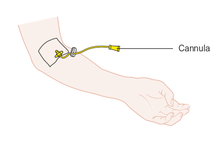Closed peripheral venous catheter systems
Closed peripheral venous catheter systems are catheters with an integrated hose extension that are closed by a special membrane and can be connected to blood collection tubes or infusion and injection accessories using a Luer lock . In contrast to the central venous catheter , a peripheral venous access is placed in an arm vein in the crook of the elbow or on the back of the hand; in some cases also on the foot.
Structure and application
The system consists of a venous catheter that is firmly connected to a short plastic tube. The tubing has a clamp and one or two Luer lock connectors or a three-way stopcock to which infusion lines, injection syringes and blood collection tubes can be connected.
The catheter is placed in a peripheral vein with a steel cannula inside. The steel cannula is pulled out, the catheter is completely closed by a membrane, the so-called septum. This means that no blood can escape, and it enables airtight, sterile , needle-free vascular access for administering fluids and medication as well as for taking blood. The connectors are firmly attached to the extension hose so that there is no risk of contamination when connecting or removing accessories near the puncture site.
Background of the mission
In Germany it is around 900 patients with central vascular catheter by conventional catheter annually associated catheter-to so-called infections that of a "simple" phlebitis (phlebitis) to sepsis rich. This risk also exists with peripheral venous access systems. However, these infections are currently not recorded in the Hospital Infection Surveillance System (KISS) of the National Reference Center for Surveillance of Nosocomial Infections (NRZ).
The openings on the cone of venous catheters or on three-way stopcocks represent entry portals for pathogens. Hygiene errors when opening, attaching accessories or closing can promote infections. In order to reduce the risk, membrane connectors with a valve function have been developed that can be screwed onto three-way stopcocks or onto the extension piece of indwelling cannulas. Required accessories are attached directly to the connector. Valve membrane connectors open when the syringe cone pushes a rubber membrane inward. This pushes a steel cannula located inside the connector into the syringe cone. With the split septum connector, a two-part plastic membrane opens like a sliding door when the syringe is attached.
Compared to the open system
When using a conventional “open” intravenous catheter, the punctured vein must be briefly squeezed shut when pulling out the steel cannula so that no blood escapes. In addition, necessary accessories must be attached or removed directly from the catheter. Such manipulations near the puncture site always move the catheter slightly, which in addition to the increased risk of contamination irritates the tissue and thus increases the risk of phlebitis.
Using the closed catheter systems, which do not have to be put together first, reduces the risk of inflammation and thus also the risk of dangerous sepsis. Ready-to-use rinsing solutions can also minimize the risk of infection. In addition, closed catheter systems can be left longer than open; about 144.5 hours on average compared to about 99 hours.
swell
- National reference center for the observation of nosocomial infections: KISS Hospital Infection Surveillance System, calculation period: January 2002 to December 2006.
Individual evidence
- ^ Marianne Abele-Horn: Antimicrobial Therapy. Decision support for the treatment and prophylaxis of infectious diseases. With the collaboration of Werner Heinz, Hartwig Klinker, Johann Schurz and August Stich, 2nd, revised and expanded edition. Peter Wiehl, Marburg 2009, ISBN 978-3-927219-14-4 , pp. 49-60 ( catheter-associated infections ).
- ↑ Hardy-Thorsten Panknin: Increase in venous catheter-associated septicemia after the introduction of a new valve connector. In: intense. 17, 2009, p. 98, doi : 10.1055 / s-0028-1109273 .
- ↑ JL González López, A. Arribi Vilela, E. Fernández del Palacio, J. Olivares Corral, C. Benedicto Martí, P. Herrera Portal: Indwell times, complications and costs of open vs closed safety peripheral intravenous catheters: a randomized study. In: Journal of Hospital Infection . Volume 862, 2014, pp. 117–126, doi : 10.1016 / j.jhin.2013.10.008 . ( free full text )
